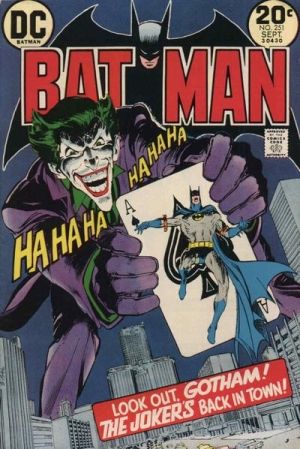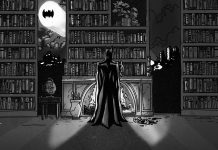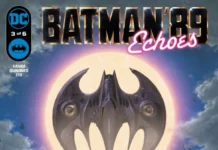 After the cancellation of the wildly successful 1966-68 ABC television program Batman, the character basically disappeared from view as far as the general public was concerned. The camp craze that surrounded the show came to an abrupt end, and all of the “POWs,” “BAMs” and “ZOWIEs” that went along with it faded from the national spotlight. However, the years immediately following the show’s demise were incredibly eventful ones for the Batman of the comic books. DC Comics was left with a commodity that to the majority of the general public appeared to be washed up – but to many comic book fans, Batman remained a treasured icon. So in an ironic twist, the end of the TV show and Batman’s widespread popularity would end up leading to a major revitalization of the character. Free from the masses who enjoyed regarding Batman as a silly, throwaway piece of pop culture, DC Comics decided to let a new breed of comic book writers and artists return the character to his dark 1930’s roots. DC allowed this new creative talent to send Dick Grayson off to a college outside of Gotham City, and Batman once again prowled the night as a lone vigilante.
After the cancellation of the wildly successful 1966-68 ABC television program Batman, the character basically disappeared from view as far as the general public was concerned. The camp craze that surrounded the show came to an abrupt end, and all of the “POWs,” “BAMs” and “ZOWIEs” that went along with it faded from the national spotlight. However, the years immediately following the show’s demise were incredibly eventful ones for the Batman of the comic books. DC Comics was left with a commodity that to the majority of the general public appeared to be washed up – but to many comic book fans, Batman remained a treasured icon. So in an ironic twist, the end of the TV show and Batman’s widespread popularity would end up leading to a major revitalization of the character. Free from the masses who enjoyed regarding Batman as a silly, throwaway piece of pop culture, DC Comics decided to let a new breed of comic book writers and artists return the character to his dark 1930’s roots. DC allowed this new creative talent to send Dick Grayson off to a college outside of Gotham City, and Batman once again prowled the night as a lone vigilante.
Writer Denny O’Neil and artist Neal Adams were the most notable of these new Batman storytellers – their first Batman collaboration was the story “The Secret of the Waiting Graves” published in Detective Comics #395, January 1970. In the tale, they depicted Batman as a grim detective whose costume featured the long ears, angular cowl and dramatically flowing cape of Bob Kane’s and Bill Finger’s original vision. O’Neil’s dark, emotionally complex script and Adam’s intricate figural renderings made the story’s Batman seem far more realistic than any previous version of the character had been.
Comic book fans immediately embraced the O’Neil/Adams version of Batman — throughout the first half of the 1970’s, they created a host of tales featured in Batman and Detective Comics that were hailed as Batman classics from the moment they were released. And perhaps their greatest collaboration of all was “The Joker’s Five-Way Revenge!” published in Batman #251, September 1973 — because in the story they returned the Joker from the silly prankster he had become during the 1950’s and 60’s comics to the leering, homicidal madman found in Kane’s and Finger’s original 1940’s Batman stories.
In “The Joker’s Five-Way Revenge!” the villain is ruthlessly hunting down members of his old gang because one of them betrayed him to Batman and the Gotham Police, leading to his arrest. Upon escaping from “the state hospital for the criminally insane” (Arkham Asylum had not been dreamed up as a Gotham locale yet!) the Joker kills his former henchmen one by one, with Batman hot on his trail. Batman finally catches up to the Joker at a seaside aquarium that has been closed due to a recent oil spill. The Caped Crusader is just in time – he manages to save the Joker’s last surviving henchman just as the villain throws the henchman into a tank containing a ravenous shark. Batman then chases the Joker down on the oil-slicked beach, delivering him to justice with several savage punches.
 It would be hard to overstate this story’s importance in Batman history – it is a virtual blueprint for all of the classic Batman/Joker confrontations that would follow, works like the Englehart/Rogers tales “The Laughing Fish!” and “The Sign of the Joker!,” Frank Miller’s Batman: The Dark Knight Returns, and Alan Moore and Brian Bolland’s The Killing Joke. “The Joker’s Five-Way Revenge!” gave us our first modern age view of a dark hero in cape and cowl battling a murderous, mirthless clown in a moody, film noir-like setting.
It would be hard to overstate this story’s importance in Batman history – it is a virtual blueprint for all of the classic Batman/Joker confrontations that would follow, works like the Englehart/Rogers tales “The Laughing Fish!” and “The Sign of the Joker!,” Frank Miller’s Batman: The Dark Knight Returns, and Alan Moore and Brian Bolland’s The Killing Joke. “The Joker’s Five-Way Revenge!” gave us our first modern age view of a dark hero in cape and cowl battling a murderous, mirthless clown in a moody, film noir-like setting.
One funny aside about the story – for some reason, Batman’s utility belt disappears during the climax of the tale. He is wearing it when he finds the Joker in the aquarium, but then it is gone when he rescues Joker’s henchman from the shark. There is no mention of Joker making Batman remove the belt – it is just suddenly not there! This story oversight has obviously puzzled not only generations of Batman fans, but also DC Comics – the story has been reprinted in a number of Batman anthologies over the years, and in some of these reprints the belt has been drawn back into the climax, and in others the belt has been simply left missing just as it was in the story’s original printing. So how about it, DC comics? Please give us a definitive explanation of just what did happen to Batman’s utility belt in “The Joker’s Five-Way Revenge!”
As far as BATMAN #251’s influence on other Batman mediums, a Viewmaster set entitled “The Joker’s Wild” was released in 1993 that was based on the story. And also in 1993, an episode of the television series Batman: The Animated Series premiered an episode entitled “The Laughing Fish” that combined the plots of “The Joker’s Five-Way Revenge!” and the previously-mentioned Englehart/Rogers story “The Laughing Fish.”
In closing, it is safe to say that even though directors Tim Burton and Christopher Nolan did not adapt “The Joker’s Five-Way Revenge!” in any direct manner, the story’s presence was felt in both BATMAN (1989) and THE DARK KNIGHT because it has been such a big influence on all Batman/Joker confrontations since its publication in 1973. – Mark S. Reinhart










